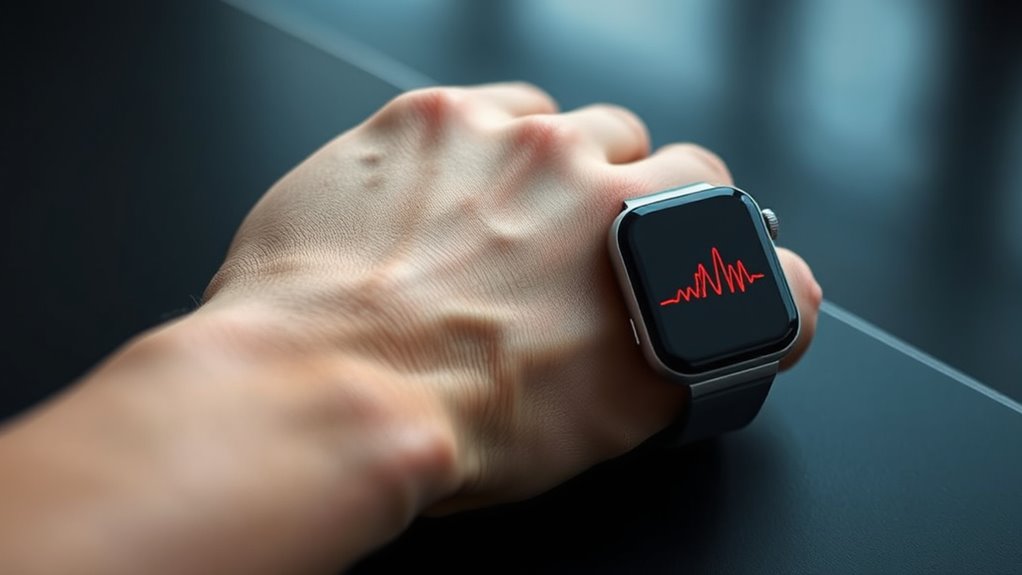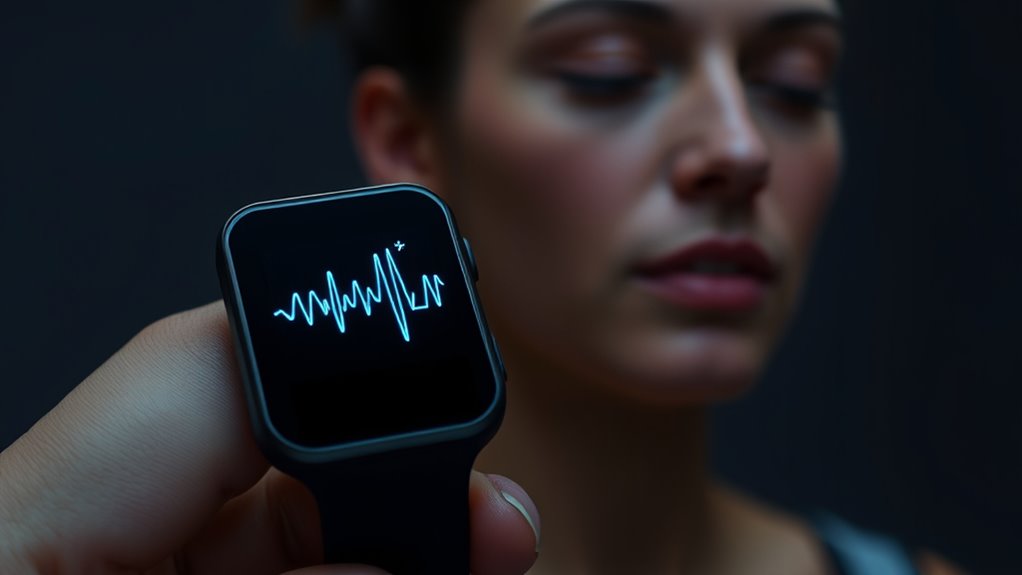Heart-rate variability (HRV) is considered the gold standard for measuring your emotional resilience because it shows how well your nervous system adapts to stress. Higher HRV indicates a balanced and responsive nervous system, helping you stay calm and focused. Low HRV can mean you’re overwhelmed or struggling with stress. By understanding and tracking your HRV, you gain insight into your resilience—something you’ll discover more about as you explore ways to optimize your well-being.
Key Takeaways
- HRV reflects the balance between sympathetic and parasympathetic nervous system activity, indicating emotional resilience.
- Higher HRV is associated with better stress regulation and adaptive emotional responses.
- Monitoring HRV provides real-time feedback on nervous system health and resilience capacity.
- Consistent HRV improvement through stress management and fitness enhances emotional stability.
- HRV serves as a reliable, non-invasive biomarker for assessing overall emotional and physiological resilience.

Heart-rate variability (HRV) is a vital indicator of your body’s ability to adapt to stress and maintain balance. When your HRV is high, your nervous system can effectively respond to challenges, helping you stay calm and focused under pressure. Conversely, low HRV suggests that your body may struggle with stress management, making you more prone to fatigue, anxiety, and even illness. By monitoring HRV, you gain insight into your overall resilience and how well your body handles emotional and physical stressors. This makes HRV an invaluable tool for optimizing your well-being and performance.
High HRV reflects strong resilience and effective stress response, promoting calmness and focus under pressure.
One of the key ways to improve HRV is through effective stress management. When you’re constantly overwhelmed, your sympathetic nervous system, responsible for the fight-or-flight response, becomes dominant, reducing HRV. Incorporating relaxation techniques like deep breathing, meditation, or yoga can help shift your nervous system back to a parasympathetic state, promoting recovery and stability. Regularly practicing these methods not only enhances your emotional resilience but also boosts your HRV over time. It’s about creating a routine that helps you decompress and reset, making you less reactive to daily stressors.
Physical fitness plays a significant role in increasing HRV, too. Engaging in regular aerobic exercises, such as brisk walking, cycling, or swimming, strengthens your heart and improves cardiovascular health. As your fitness level improves, so does your autonomic nervous system’s ability to regulate heart rate variability. Over time, consistent physical activity enhances your capacity to recover quickly from stress and physical exertion, which reflects in higher HRV scores. Strength training and high-intensity interval training (HIIT) can also contribute to better autonomic balance, provided you don’t overdo it. The key is maintaining consistency, listening to your body, and gradually increasing intensity to avoid burnout.
It’s important to understand that improving HRV isn’t about quick fixes but rather adopting sustainable habits that support your overall health. Prioritize sleep, hydration, and a balanced diet alongside physical activity and stress management techniques. When you do, you’ll notice a more resilient nervous system, better emotional control, and a greater capacity to handle life’s ups and downs. Additionally, incorporating glycolic acid into skincare routines may help in controlling skin-related stressors, contributing to overall well-being. Tracking your HRV can serve as a motivational feedback loop, helping you refine your routines and celebrate progress. Remember, boosting HRV isn’t just about physical fitness; it’s about cultivating a resilient mind and body that can adapt gracefully to whatever challenges come your way.
Frequently Asked Questions
How Does HRV Differ Between Men and Women?
You might notice HRV differs between men and women because hormonal differences influence autonomic nervous system activity, affecting resilience. Societal influences also shape how each gender manages stress, impacting HRV levels. Women often display higher HRV during certain phases of their menstrual cycle, reflecting hormonal fluctuations. Overall, these factors contribute to distinct HRV patterns, highlighting the importance of considering both biological and societal influences when evaluating emotional resilience.
Can HRV Predict Future Emotional Health Issues?
Imagine knowing your emotional future before it unfolds. Heart-rate variability holds clues for emotional forecasting and mental wellness prediction. While it can’t guarantee perfect foresight, a high HRV suggests resilience and stability, hinting at fewer future issues. Conversely, low HRV might signal vulnerability. You’re not just reacting to today’s stress—you’re gaining insights into tomorrow’s emotional landscape, empowering you to take proactive steps toward lasting mental health.
Are There Specific Activities That Improve HRV Quickly?
You can boost your HRV quickly through activities like breathing exercises and meditation techniques. Deep, slow breaths activate your parasympathetic nervous system, helping you relax and improve HRV. Regular meditation also enhances emotional resilience by reducing stress. Incorporate these practices daily, especially during stressful moments, to see rapid improvements in your HRV and overall emotional health. Consistency is key for lasting benefits.
How Does Sleep Quality Affect HRV Measurements?
Imagine a peaceful night’s sleep as a calm river, versus sleep deprivation as turbulent waters. When your sleep is restful, your HRV improves, reflecting better emotional resilience. Poor sleep, marked by low sleep quality and disrupted dream quality, lowers HRV. You wake up feeling stressed and less adaptable. Prioritize good sleep habits to boost HRV, helping your body recover and your mind stay resilient.
Is HRV Influenced by Age or Fitness Level?
Age impact and fitness influence notably shape your HRV readings. As you age, your HRV tends to decline, reflecting reduced autonomic flexibility. Conversely, higher fitness levels boost your HRV by strengthening your nervous system’s resilience. Regular exercise can help counteract age effects, maintaining better emotional resilience. So, both age and fitness are key factors that impact your HRV, revealing your body’s capacity to adapt to stress.
Conclusion
By understanding and tracking your heart-rate variability, you gain a powerful tool to boost your emotional resilience. It’s your body’s way of showing how well you adapt to stress and recover. So, why not take control of your emotional health today? Monitoring HRV could be your key to lasting resilience and better well-being. Are you ready to listen to your body’s signals and strengthen your mental resilience from within?










